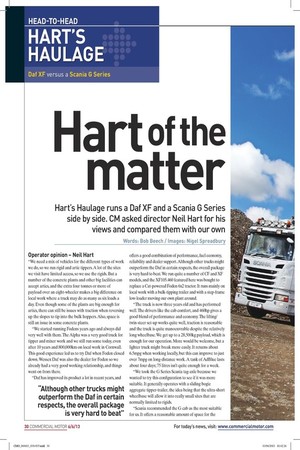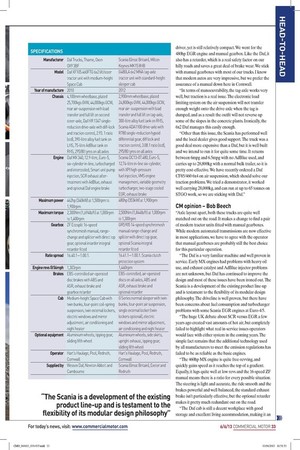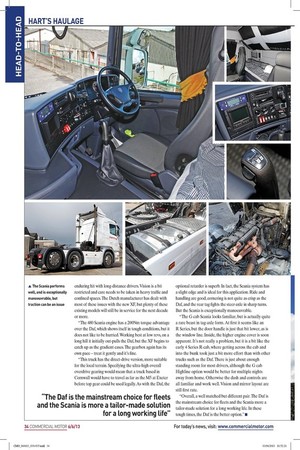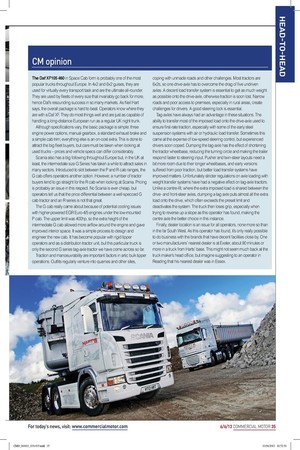Hart of the matter Hart's Haulage runs a Daf XF
Page 24

Page 27

Page 28

Page 29

If you've noticed an error in this article please click here to report it so we can fix it.
and a Scania G Series side by side. CM asked director Neil Hart for his views and compared them with our own Words: Bob Beech / Images: Nigel Spreadbury Operator opinion Neil Hart "We need a mix of vehicles for the different types of work we do, so we run rigid and artic tippers. A lot of the sites we visit have limited access, so we use the rigids. But a number of the concrete plants and other big facilities can accept artics, and the extra four tonnes or more of payload over an eight-wheeler makes a big difference on local work where a truck may do as many as six loads a day. Even though some of the plants are big enough for artics, there can still be issues with traction when reversing up the slopes to tip into the bulk hoppers. Also, space is still an issue in some concrete plants.
"We started running Fodens years ago and always did very well with them. The Alpha was a very good truck for tipper and mixer work and we still run some today, even after 10 years and 800,000km on local work in Cornwall. This good experience led us to try Daf when Foden closed down. Wessex Daf was also the dealer for Foden so we already had a very good working relationship, and things went on from there.
"Dot has improved its product a lot in recent years, and offers a good combination of performance, fuel economy, reliability and dealer support. Although other trucks might outperform the Daf in certain respects, the overall package is very hard to beat. We run quite a number of CF and XF models, and the XF105.460 featured here was bought to replace a Cat-powered Foden 6x2 tractor. It runs mainly on local work with a bulk-tipping trailer and with a step-frame low-loader moving our own plant around.
"The truck is now three years old and has performed well. The drivers like the cab comfort, and 460hp gives a good blend of performance and economy. The lifting/ twin-steer set-up works quite well, traction is reasonable and the truck is quite manoeuvrable despite the relatively long wheelbase. We get up to a 28,500kg payload, which is enough for our operation. More would be welcome, but a lighter truck might break more easily. It returns about 6.5mpg when working locally, but this can improve to just over 7mpg on long-distance work. A tank of AdBlue lasts about four days; 75 litres isn't quite enough for a week.
"We took the G Series Scania tag-axle because we wanted to try this configuration to see if it was more suitable. It generally operates with a sliding bogie aggregate tipper-trailer, the idea being that the ultra-short wheelbase will allow it into really small sites that are normally limited to rigids.
"Scania recommended the G cab as the most suitable for us. It offers a reasonable amount of space for the driver, yet is still relatively compact. We went for the 480hp EGR engine and manual gearbox. Like the Daf, it also has a retarder, which is a real safety factor on our hilly roads and saves a great deal of brake wear. We stick with manual gearboxes with most of our trucks. I know that modern autos are very impressive, but we prefer the assurance of a manual down here in Cornwall.
"In terms of manoeuvrability, the tag-axle works very well, but traction is a real issue. The electronic load limiting system on the air suspension will not transfer enough weight onto the drive-axle when the tag is dumped, and as a result the outfit will not reverse up some of the slopes in the concrete plants. Ironically, the 6x2 Daf manages this easily enough.
"Other than this issue, the Scania has performed well and the local dealer gives good support. The truck was a good deal more expensive than a Daf, but it is well built and we intend to run it for quite some time. It returns between 6mpg and 6.5mpg with no AdBlue used, and carries up to 28,800kg with a normal bulk trailer, so it is pretty cost-effective. We have recently ordered a Daf CF85/460 6x4 on air suspension, which should solve our traction problems. We tried a demonstrator, it worked well carrying 28,000kg, and can run at up to 65 tonnes on STGO work, so we are sticking with Daf."
CM opinion Bob Beech "Axle layout apart, both these trucks are quite well matched out on the road. It makes a change to find a pair of modern tractor units fitted with manual gearboxes. While modern automated transmissions are now effective in most applications, we have to agree with the operator that manual gearboxes are probably still the best choice for this particular operation.
"The Daf is a very familiar machine and well proven in service. Early MX engines had problems with heavy oil use, and exhaust catalyst and AdBlue injector problems are not unknown, but Daf has continued to improve the design and most of these issues have been ironed out. The Scania is a development of the existing product line-up and is testament to the flexibility of its modular design philosophy. The driveline is well proven, but there have been concerns about fuel consumption and turbocharger problems with some Scania EGR engines at Euro-4/5.
"The huge UK debate about SCR versus EGR a few years ago created vast amounts of hot air, but completely failed to highlight what real in-service issues operators would face with either system in the coming years. The simple fact remains that the additional technology used by all manufacturers to meet the emission regulations has failed to be as reliable as the basic engines.
"The 460hp MX engine is quite free-revving, and quickly gains speed as it reaches the top of a gradient. Equally, it lugs quite well at low revs and the 16-speed ZF manual means there is a ratio for every possible situation. The steering is light and accurate, the ride smooth and the brakes powerful and well balanced, the standard exhaust brake isn't particularly effective, but the optional retarder makes it pretty much redundant out on the road.
"The Daf cab is still a decent workplace with good storage and excellent living accommodation, making it an enduring hit with long-distance drivers. Vision is a bit restricted and care needs to be taken in heavy traffic and confined spaces. The Dutch manufacturer has dealt with most of these issues with the new XF, but plenty of these existing models will still be in service for the next decade or more.
"The 480 Scania engine has a 200Nm torque advantage over the Daf, which shows itself in tough conditions, but it does not like to be hurried. Working best at low revs, on a long hill it initially out-pulls the Daf, but the XF begins to catch up as the gradient eases. The gearbox again has its own pace — treat it gently and it's fine.
"This truck has the direct-drive version, more suitable for the local terrain. Specifying the ultra-high overall overdrive gearing would mean that a truck based in Cornwall would have to travel as far as the M5 at Exeter before top gear could be used legally. As with the Daf, the optional retarder is superb. In fact, the Scania system has a slight edge and is ideal for this application. Ride and handling are good, cornering is not quite as crisp as the Daf, and the rear tag fights the steer-axle in sharp turns. But the Scania is exceptionally manoeuvrable.
"The G cab Scania looks familiar, but is actually quite a rare beast in tag-axle form. At first it seems like an R Series, but the door handle is just that bit lower, as is the window line. Inside, the higher engine cover is soon apparent. It's not really a problem, but it is a bit like the early 4 Series R-cab, where getting across the cab and into the bunk took just a bit more effort than with other trucks such as the Daf. There is just about enough standing room for most drivers, although the G cab Highline option would be better for multiple nights away from home. Otherwise the dash and controls are all familiar and work well. Vision and mirror layout are still first rate.
"Overall, a well matched but different pair. The Daf is the mainstream choice for fleets and the Scania more a tailor-made solution for a long working life. In these tough times, the Daf is the better option." • SPECIFICATIONS Scania (Great Britain], Milton Keynes MK15 8HB 0480 LA 6x2 MNA tag-axle tractor unit with standard-height sleeper cab 2012 2,900mm wheelbase, plated 24,800kgs GVW, 44,000kgs GCW, rear airsuspension with load transfer and full lift on tag-axle, 300-litre alloy fueltank on RHS, Scania ADA1100 drive-axle with R780 single-reduction hypoid differential gear, diff lock and traction control, 3.08.1 ratio (std], 295/80 tyres on all axles Scania DC13-07.480, Euro-5, 12.74-litre in-line six-cylinder, with XPI high-pressure fuel injection, VMS engine management, variable geometry turbocharger two-stage cooled EGR, exhaust brake 480hp (353kW] at 1,900rpm 2,500N m (1,8441.b/ft] at 1,000rpm to 1,300rpm 0R5905 14-speed synchromesh manual range-change and splitterwith direct top gear, optional Scania integral retarder fitted 16.41.1-1.00.1. Scania clutch protection system 1,44Orpm EBS-controlled, air-operated discs on all axles, ABS and ASR, exhaust brake and optional retarder G Series normal sleeperwith twin bunks, four-point air suspension, single external locker (twin Lockers optional], electric windows and mirror adjustment, air conditioning and night heater Aluminium wheels, side skirts, upright exhaust, tipping gear, sliding fifth wheel Hart's Haulage, Pool, Redruth, Cornwall Scania (Great Britain], Exeter and Redruth Manufacturer Year of manufacture Chassis 4,100mm wheelbase, plated Daf Trucks, Thame, Oxon OX9 3BF Model Daf XF105.460FTG 6x2 lift/steer tractor unit with medium-height Space Cab 2010 Maximum power 462hp (340kW] at 1,500rpm to 1,90Orpm Maximum torque 2,300Nm (1,6941.b/ft] at 1,000rpm to 1,400rpm Gearbox ZF Ecosplit 16-speed synchromesh manual, rangechange and splitterwith direct top gear optional intarder integral retarder fitted Ratio spread 16.40.1-1.00.1. 25,700kgs GVW, 44,000kgs GCW, rear air-suspension with load transfer and full lift on second steer-axle, Daf HR 1347 singlereduction drive-axle with diff-lock and traction control, 2.93. 1 ratio (std], 390-litre alloy fuel tank on LHS, 75-litre AdBlue tank on RHS, 295/80 tyres on all axles Engine Daf MX 340, 12.9-litre, Euro-5, six-cylinder in-line, turbocharged and intercooled, Smart unit pump injection, SCR exhaust aftertreatment with Ad Blue, exhaust and optional Daf engine brake Engine revs la 56mph Brakes 1,303rpm EBS-controlled air-operated disc brakes with ABS and ASR, exhaust brake and gearbox retarder Cab Medium-height Space Cab with twin bunks, four-point coil-spring suspension, twin external lockers, electric windows and mirror adjustment, air conditioning and night heater Optional equipment Aluminium wheels, tipping gear, sliding fifth wheel Operator Hart's Haulage, Pool, Redruth, Cornwall Supplied by Wessex Daf, Newton Abbott and Camboume CM opinion The Daf XF105 460 in Space Cab form is probably one of the most popular trucks throughout Europe. In 4x2 and 6x2 guises, they are used for virtually every transport task and are the ultimate all-rounder. They are used by fleets of every size that invariably go back for more, hence Daf's resounding success in so many markets. As Neil Hart says, the overall package is hard to beat. Operators know where they are with a Daf XF. They do most things well and are just as capable of handling a long-distance European run as a regular UK night trunk.
Although specifications vary, the basic package is simple: three engine power options, manual gearbox, a standard exhaust brake and a simple cab trim; everything else is an on-cost extra. This is done to attract the big fleet buyers, but care must be taken when looking at used trucks — prices and vehicle specs can differ considerably.
Scania also has a big following throughout Europe but, in the UK at least, the intermediate size G Series has taken a while to attract sales in many sectors. Introduced to slot between the P and R cab ranges, the G cab offers operators another option. However, a number of tractor buyers tend to go straight for the R cab when looking at Scania. Pricing is probably an issue in this respect. No Scania is ever cheap, but operators tell us that the price differential between a well-specced G cab tractor and an R series is not that great.
The G cab really came about because of potential cooling issues with higher-powered EGR Euro-4/5 engines under the low-mounted P cab. The upper limit was 400hp, so the extra height of the intermediate G cab allowed more airflow around the engine and gave improved interior space. It was a simple process to design and engineer the new cab. It has become popular with rigid tipper operators and as a distribution tractor unit, but this particular truck is only the second G series tag-axle tractor we have come across so far.
Traction and manoeuvrability are important factors in artic bulk tipper operations. Outfits regularly venture into quarries and other sites, coping with unmade roads and other challenges. Most tractors are 6x2s, so one drive-axle has to overcome the drag of five undriven axles. A decent load transfer system is essential to get as much weight as possible onto the drive-axle, otherwise traction is soon lost. Narrow roads and poor access to premises, especially in rural areas, create challenges for drivers. A good steering lock is essential.
Tag-axles have always had an advantage in these situations. The ability to transfer most of the imposed load onto the drive-axle used to ensure first-rate traction, especially with some of the early steel suspension systems with air or hydraulic load transfer. Sometimes this came at the expense of low-speed steering control, but experienced drivers soon coped. Dumping the tag-axle has the effect of shortening the tractor wheelbase, reducing the turning circle and making the trailer respond faster to steering input. Pusher and twin-steer layouts need a bit more room due to their longer wheelbases, and early versions suffered from poor traction, but better load transfer systems have improved matters. Unfortunately stricter regulations on axle loading with weight transfer systems have had a negative effect on tag-axle tractors. Unlike a centre-lift, where the extra imposed load is shared between the driveand front-steer axles, dumping a tag axle puts almost all the extra load onto the drive, which often exceeds the preset limit and deactivates the system. The truck then loses grip, especially when trying to reverse up a slope as this operator has found, making the centre axle the better choice in this instance.
Finally, dealer location is an issue for all operators, none more so than in the far South West. As this operator has found, it's only really possible to do business with the brands that have decent facilities close by. One or two manufacturers' nearest dealer is at Exeter, about 90 minutes or more in a truck from Harts' base. This might not seem much back at the truck maker's head office, but imagine suggesting to an operator in Reading that his nearest dealer was in Essex.










































